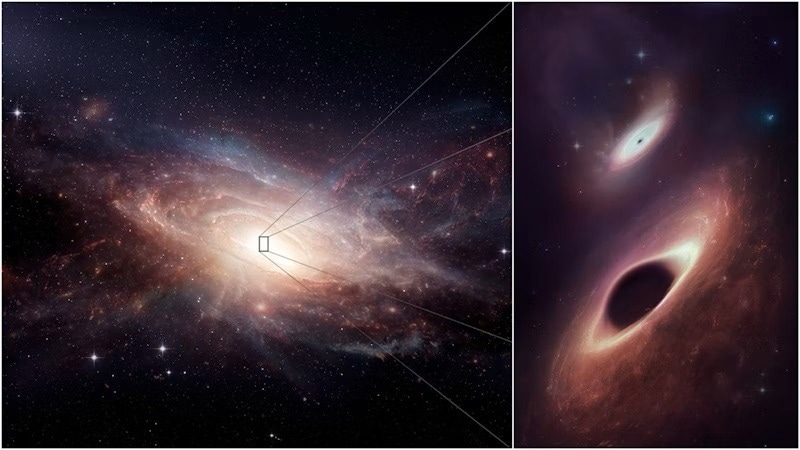New analysis and remarks made by the scientists from the Flatiron Institute and their collaborators show two Goliath black holes 750 light-years apart and closing in on eachother, as they surround each other in the effect of a galaxy merger.

This artist’s conception shows a late-stage galaxy merger and its two newly-discovered central black holes. The binary black holes are the closest together ever observed in multiple wavelengths. Image Credit: ALMA (ESO/NAOJ/NRAO); M. Weiss, NRAO/AUI/NSF
Two ghostly Goliaths en route to a cataclysmic meeting have been spotted by astronomers. The recently discovered pair of supermassive black holes are known as the closest to colliding ever witnessed and the astronomers announced this on January 9th, 2023, at an American Astronomical Society meeting in Seattle and in a paper published in The Astrophysical Journal Letters.
At just 750 light-years apart, while being close together in cosmological terms, the supermassive black holes will not be able to combine for a few hundred million years. At the same time, the breakthrough of astronomers offers an improved estimate of how many supermassive black holes are also approaching collision in the universe.
The brief distance between the newly found black holes “is fairly close to the limit of what we can detect, which is why this is so exciting,” states study co-author Chiara Mingarelli, an associate research scientist at the Flatiron Institute’s Center for Computational Astrophysics in New York City.
As a result of the small separation present between the black holes, astronomers could only distinguish between the two objects by integrating several observations made from seven telescopes, such as NASA’s Hubble Space Telescope.
(Even though supermassive black holes are not directly visible via an optical telescope, they are encircled by bright bunches of warm gas and luminous stars drawn in by their gravitational pull).
The astronomers discovered the pair as soon as they started looking, which showed that the close-together supermassive black holes “are probably more common than we think, given that we found these two and we didn’t have to look very far to find them,” states Mingarelli.
The newly determined supermassive black holes tend to inhabit a mash-up of two galaxies that collided nearly 480 million light-years away from Earth. Gargantuan black holes survive in the heart of the majority of galaxies. This helps them grow greater by eating up the surrounding dust, gas, stars, and also other black holes.
In this study, the two supermassive black holes determined are considered true heavyweights: They show up at 200 million and 125 million times the mass of the sun.
The black holes were encountered as their host galaxies smashed into each other. Ultimately, they will start surrounding each other, with the orbit tightening as gas and stars pass between the two black holes and steal orbital energy.
Lastly, the black holes will begin to produce gravitational waves in a more powerful way compared to any that have been detected before. This will happen before they crash into each other to develop one enormous black hole.
Only a single supermassive black hole was noted in the earlier observations made of the merging galaxies. Since the two objects are kept so close together, researchers were not able to accurately tell them apart with a single telescope.
The new survey, headed by Michael J. Koss of Eureka Scientific in Oakland, California, integrated 12 observations that have been made on seven telescopes on Earth and in orbit. Even though no single observation was sufficient to verify their presence, the integrated data decisively helped reveal the two black holes.
It’s important that with all these different images, you get the same story—that there are two black holes. This is where other studies [of close-proximity supermassive black holes] have fallen down in the past. When people followed them up, it turned out that there was just one black hole. [This time we] have many observations, all in agreement.
Chiara Mingarelli, Study Co-Author and Associate Research Scientist, Center for Computational Astrophysics, Flatiron Institute
Mingarelli stated this while making a comparison of this new multi-observation research with previous measures.
She and Flatiron Institute visiting scientist Andrew Casey-Clyde made use of the new observations to evaluate the universe’s population of merging supermassive black holes, stating the fact that it “may be surprisingly high,” Mingarelli says.
They anticipate that plenty of supermassive black-hole pairs exist, producing a significant amount of ultra-strong gravitational waves. All that clamor must lead to a loud gravitational-wave background that is very simple to detect compared to if the population were smaller. Hence, the first-ever detection of the background babble of gravitational waves might come “very soon,” stares Mingarelli.
Journal Reference:
Koss, M. J., et al. (2022) UGC 4211: A Confirmed Dual Active Galactic Nucleus in the Local Universe at 230 pc Nuclear Separation. The Astrophysical Journal Letters. doi.org/10.3847/2041-8213/aca8f0.